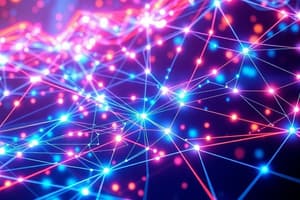Podcast
Questions and Answers
Which OSI layer is responsible for determining the best path for data packets to travel across a network?
Which OSI layer is responsible for determining the best path for data packets to travel across a network?
- Session Layer
- Data Link Layer
- Transport Layer
- Network Layer (correct)
At which layer of the OSI model does data encryption primarily occur?
At which layer of the OSI model does data encryption primarily occur?
- Transport Layer
- Application Layer
- Session Layer
- Presentation Layer (correct)
Which layer of the OSI model is responsible for providing reliable data transfer using TCP?
Which layer of the OSI model is responsible for providing reliable data transfer using TCP?
- Transport Layer (correct)
- Network Layer
- Session Layer
- Data Link Layer
In the OSI model, which layer is closest to the end user and provides network services to applications?
In the OSI model, which layer is closest to the end user and provides network services to applications?
Which layer of the OSI model is responsible for establishing, maintaining, and terminating connections between applications?
Which layer of the OSI model is responsible for establishing, maintaining, and terminating connections between applications?
What is the primary function of the Data Link Layer in the OSI model?
What is the primary function of the Data Link Layer in the OSI model?
Which of the following protocols operates at the Application Layer of the OSI model?
Which of the following protocols operates at the Application Layer of the OSI model?
Which OSI layer is responsible for converting data formats to ensure compatibility between different systems?
Which OSI layer is responsible for converting data formats to ensure compatibility between different systems?
In the context of the OSI model, what does 'encapsulation' refer to?
In the context of the OSI model, what does 'encapsulation' refer to?
At which layer of the OSI model does the TCP protocol primarily operate?
At which layer of the OSI model does the TCP protocol primarily operate?
Which OSI layer defines the physical characteristics of the network, such as voltages and data rates?
Which OSI layer defines the physical characteristics of the network, such as voltages and data rates?
What is the role of MAC addresses in the OSI model?
What is the role of MAC addresses in the OSI model?
Which of the following is NOT a function of the Presentation Layer in the OSI model?
Which of the following is NOT a function of the Presentation Layer in the OSI model?
What is the purpose of the OSI model?
What is the purpose of the OSI model?
Which layer of the OSI model is responsible for segmenting data into smaller units for transmission?
Which layer of the OSI model is responsible for segmenting data into smaller units for transmission?
What is the main difference between the TCP/IP model and the OSI model?
What is the main difference between the TCP/IP model and the OSI model?
Which layer of the OSI model would a network administrator troubleshoot when experiencing issues with physical cables and connectors?
Which layer of the OSI model would a network administrator troubleshoot when experiencing issues with physical cables and connectors?
At which OSI model layer does error detection and correction primarily take place?
At which OSI model layer does error detection and correction primarily take place?
What is the term for removing headers and trailers from data as it moves up the OSI model layers towards the application?
What is the term for removing headers and trailers from data as it moves up the OSI model layers towards the application?
Why is the OSI model considered useful in network troubleshooting?
Why is the OSI model considered useful in network troubleshooting?
Flashcards
Local Area Network (LAN)
Local Area Network (LAN)
Connects devices in a limited area like a home, school, or office.
Wide Area Network (WAN)
Wide Area Network (WAN)
Connects devices over a large geographical area, like the internet.
Metropolitan Area Network (MAN)
Metropolitan Area Network (MAN)
Connects devices within a city or metropolitan area.
Bus Topology
Bus Topology
Signup and view all the flashcards
Star Topology
Star Topology
Signup and view all the flashcards
Ring Topology
Ring Topology
Signup and view all the flashcards
Mesh Topology
Mesh Topology
Signup and view all the flashcards
Router
Router
Signup and view all the flashcards
Switch
Switch
Signup and view all the flashcards
Hub
Hub
Signup and view all the flashcards
Modem
Modem
Signup and view all the flashcards
TCP/IP
TCP/IP
Signup and view all the flashcards
DNS
DNS
Signup and view all the flashcards
Firewall
Firewall
Signup and view all the flashcards
Application Layer (OSI Layer 7)
Application Layer (OSI Layer 7)
Signup and view all the flashcards
Presentation Layer (OSI Layer 6)
Presentation Layer (OSI Layer 6)
Signup and view all the flashcards
Session Layer (OSI Layer 5)
Session Layer (OSI Layer 5)
Signup and view all the flashcards
Transport Layer (OSI Layer 4)
Transport Layer (OSI Layer 4)
Signup and view all the flashcards
Network Layer (OSI Layer 3)
Network Layer (OSI Layer 3)
Signup and view all the flashcards
Data Link Layer (OSI Layer 2)
Data Link Layer (OSI Layer 2)
Signup and view all the flashcards
Study Notes
- Computer networking involves the exchange of data between devices over a communication medium
- It enables resource sharing, communication, and access to information
Network Types
- Local Area Network (LAN): Connects devices in a limited area like a home, school, or office
- Wide Area Network (WAN): Connects devices over a large geographical area, like the internet
- Metropolitan Area Network (MAN): Connects devices within a city or metropolitan area
- Personal Area Network (PAN): Connects devices in a small area, typically around an individual
Network Topologies
- Bus Topology: All devices are connected to a central cable, called the bus
- Simple to implement but a break in the bus can disrupt the entire network
- Star Topology: All devices are connected to a central node, like a hub or switch
- Easy to troubleshoot, but the central node's failure can affect the entire network
- Ring Topology: Each device is connected to two other devices, forming a ring
- Data travels in one direction, but a break in the ring can disrupt the network
- Mesh Topology: Each device is connected to many other devices
- Highly redundant and reliable, but complex and expensive
- Tree Topology: Combines characteristics of linear bus and star topologies, consists of groups of star-configured workstations connected to a linear bus backbone cable
- Provides scalability and hierarchy
Key Network Devices
- Router: Forwards data packets between networks
- Operates at the network layer
- Switch: Connects devices within a network
- Operates at the data link layer
- Hub: Connects devices within a network
- Operates at the physical layer, broadcasts data to all connected devices
- Modem: Modulates and demodulates signals for transmission over communication channels
Communication Protocols
- TCP/IP (Transmission Control Protocol/Internet Protocol): Suite of protocols governing internet communication
- HTTP (Hypertext Transfer Protocol): For web communication
- FTP (File Transfer Protocol): For file transfer
- SMTP (Simple Mail Transfer Protocol): For email transmission
- DNS (Domain Name System): Translates domain names to IP addresses
IP Addressing
- IPv4: 32-bit address, represented in dotted decimal notation
- IPv6: 128-bit address, represented in hexadecimal notation
- Private IP addresses: Used within private networks and not routable on the internet
- Public IP addresses: Used for communication on the internet
Subnetting
- Dividing a network into smaller subnetworks for better management and security
- Involves borrowing bits from the host portion of an IP address to create subnetworks
- Subnet mask: Used to identify the network and host portions of an IP address
Network Security
- Firewall: A network security system that monitors and controls incoming and outgoing network traffic based on predetermined security rules
- VPN (Virtual Private Network): Establishes a secure connection over a public network
- Encryption: Encoding data to protect its confidentiality
Wireless Networking
- Wi-Fi: Wireless communication technology based on the IEEE 802.11 standards
- Bluetooth: Wireless technology for short-range communication
The OSI Model
- The Open Systems Interconnection (OSI) model is a conceptual framework
- It standardizes the functions of a telecommunication or computing system
- Characterized by a layered approach
- This model divides the communication system into seven abstract layers
Seven Layers of the OSI Model
- Each layer has specific functions
Layer 7: Application Layer
- Provides network services to applications
- Examples: HTTP, FTP, SMTP, DNS
- Provides interfaces for applications to access network services
- Deals with high-level protocols and data interpretation for applications
- It's the layer closest to the end user
Layer 6: Presentation Layer
- Handles data representation, encryption, and decryption
- Ensures that data is in a usable format for the application layer
- Converts data formats between different systems
- Handles character encoding, data compression, and encryption
Layer 5: Session Layer
- Manages connections between applications
- Establishes, maintains, and terminates sessions
- Provides mechanisms for synchronization and dialogue control
- Handles authentication and authorization
Layer 4: Transport Layer
- Provides reliable and unreliable data delivery between hosts
- Uses protocols like TCP (reliable) and UDP (unreliable)
- TCP provides flow control, error correction, and retransmission
- UDP provides fast, connectionless communication
- Segments data into smaller units for transmission
Layer 3: Network Layer
- Handles routing of data packets between networks
- Uses IP addresses to identify hosts
- Determines the best path for data to travel
- Uses protocols like IP, ICMP, and routing protocols
- Implements logical addressing
Layer 2: Data Link Layer
- Provides error-free transmission of data between adjacent nodes
- Uses MAC addresses to identify devices
- Divides data into frames
- Implements error detection and correction mechanisms
- Protocols: Ethernet, PPP, Frame Relay
Layer 1: Physical Layer
- Transmits raw bit stream over the physical medium
- Defines physical characteristics of the network
- Specifies voltages, data rates, and physical connectors
- Deals with cables, connectors, and network interface cards
Data Encapsulation and Decapsulation
- Encapsulation: Adding headers and trailers to data as it moves down the OSI model
- Decapsulation: Removing headers and trailers as data moves up the OSI model
- Each layer adds its own control information to the data
Advantages of the OSI Model
- Provides a standard framework for network communication
- Allows modular design and development
- Facilitates troubleshooting and problem isolation
- Promotes interoperability between different devices and networks
TCP/IP Model vs. OSI Model
- TCP/IP model is a simplified model with four layers: application, transport, internet, and link
- OSI model has seven layers, providing a more detailed framework
- TCP/IP model is the foundation of the internet, while the OSI model is a conceptual reference model
Studying That Suits You
Use AI to generate personalized quizzes and flashcards to suit your learning preferences.




